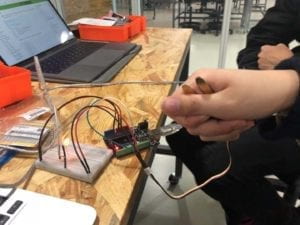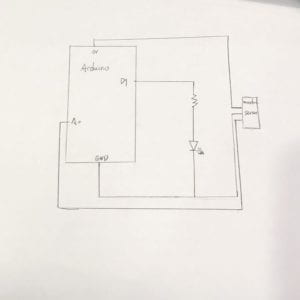Recitation 3: Sensors
Sharon Xu
Instruction: Choose one of the sensors listed below and read about what it is and how it performs. Once you have picked a sensor, build a circuit that integrates this sensor with your Arduino. Use the data (input) from your sensor to drive an output (Servo-motor, LEDs, Buzzer, etc.). Document the finished circuit and your interaction with it. In addition, draw a diagram of how all the components are connected and add this to your documentation. If you finish your circuit early, swap out the sensor in your circuit with a different sensor. Please cite any sources you reference to do this exercise.
Partner: Arthur&Olivia
Components:
- Arduino
- USB
- Breadboard
- Jumper cables
- Moisture sensor
- LED
Circuit:Moisture Sensor


We chose moisture sensor to build the circuit. First, according to the instruction, we figure out how to connect the moisture sensor with Arduino. After thinking about the “INPUT”, we built another return circuit with LED to make a “OUTPUT”, so that when the humidity reached a certain level, we could see the signal of the indicator light. And I used a part of code from the instruction to make the “INPUT” work, and then I write the code I’ve learnt in this week’s classes to make the LED work when the humidity up to a certain number. It turned out well.
Question 1:
What did you intend to assemble in the recitation exercise? If your sensor/actuator combination were to be used for pragmatic purposes, who would use it, why would they use it, and how could it be used?
We intended to assemble a circuit where LED would give out light when the humidity reached a certain level. It might be used by those busy office workers who have plants. When plants lack water, the lights go on, suggesting that people who are busy with their work should water them to avoid drought-related deaths, especially for those precious plants.
Question 2:
Code is often compared to following a recipe or tutorial. Why do you think that is?
Code is like the language that humans use to communicate with computers. People translate their design ideas into code and input them into a computer, which then executes the instructions step by step, just like following a recipe or tutorial.
Question 3:
In Language of New Media, Manovich describes the influence of computers on new media. In what ways do you believe the computer influences our human behaviors?
As what Manovich writes, because of the invention of computers, people have already used numerical representation to make the world modular, automated and variable. People thus see the world more rationally and logically. At the same time, computers use the algorithm to give humans some feedback, such as relevant recommendations and automatic association, to guide human behavior.